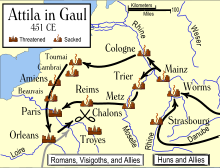451
Appearance
(Redirected from 451 CE)
| Millennium: | 1st millennium |
|---|---|
| Centuries: | |
| Decades: | |
| Years: |
This article needs additional citations for verification. (February 2024) |
| 451 by topic |
|---|
| Leaders |
| Categories |
| Gregorian calendar | 451 CDLI |
| Ab urbe condita | 1204 |
| Assyrian calendar | 5201 |
| Balinese saka calendar | 372–373 |
| Bengali calendar | −142 |
| Berber calendar | 1401 |
| Buddhist calendar | 995 |
| Burmese calendar | −187 |
| Byzantine calendar | 5959–5960 |
| Chinese calendar | 庚寅年 (Metal Tiger) 3148 or 2941 — to — 辛卯年 (Metal Rabbit) 3149 or 2942 |
| Coptic calendar | 167–168 |
| Discordian calendar | 1617 |
| Ethiopian calendar | 443–444 |
| Hebrew calendar | 4211–4212 |
| Hindu calendars | |
| - Vikram Samvat | 507–508 |
| - Shaka Samvat | 372–373 |
| - Kali Yuga | 3551–3552 |
| Holocene calendar | 10451 |
| Iranian calendar | 171 BP – 170 BP |
| Islamic calendar | 176 BH – 175 BH |
| Javanese calendar | 336–337 |
| Julian calendar | 451 CDLI |
| Korean calendar | 2784 |
| Minguo calendar | 1461 before ROC 民前1461年 |
| Nanakshahi calendar | −1017 |
| Seleucid era | 762/763 AG |
| Thai solar calendar | 993–994 |
| Tibetan calendar | 阳金虎年 (male Iron-Tiger) 577 or 196 or −576 — to — 阴金兔年 (female Iron-Rabbit) 578 or 197 or −575 |

Year 451 (CDLI) was a common year starting on Monday (link will display the full calendar) of the Julian calendar. At the time, it was known as the Year of the Consulship of Marcianus and Adelfius (or, less frequently, year 1204 Ab urbe condita). The denomination 451 for this year has been used since the early medieval period, when the Anno Domini calendar era became the prevalent method in Europe for naming years.
Events
[edit]By place
[edit]Europe
[edit]- Spring – Attila gathers his vassals—Bastarnae, Gepids, Heruls, Ostrogoths, Rugians, Scirians and Thuringians (among others), and smashes through Germany, causing widespread panic and destruction. He arrives in Belgica with an army (50,000 men) and crosses the Rhine.[citation needed]
- April 7 – Attila's forces invade Gaul and sack Metz. The major cities of Strasbourg, Worms, Mainz, Trier, Cologne, Reims, Tournai, Cambrai, Amiens and Beauvais are destroyed by the Huns.[citation needed]
- Eudocia, daughter of Emperor Valentinian III, marries Huneric in Ravenna. The engagement serves to strengthen the alliance between the Western Roman Empire and the Vandal Kingdom.[citation needed]
- June – Attila approaches Aurelianum (modern Orléans) and the city's inhabitants close the gates, forcing him to lay siege. After learning of the Hun invasion, Flavius Aetius (magister militum) moves quickly from Italy into Gaul, and joins forces with Visigoth king Theodoric I.[citation needed]
- June 20 – Battle of the Catalaunian Plains (Châlons): Attila avoids a pitched battle near Orléans, and withdraws to the Catalaunian Plains (Champagne-Ardenne). The Roman coalition defeats the Huns, but Theodoric I is killed in the encounter. This is one of the last military victories of the Western Roman Empire, before the victories of Emperor Majorian against the Alemanni, Visigoths, Suebi and Burgundians, between 457 and 461.[citation needed]
- Thorismund succeeds his father Theodoric I as king of the Visigoths. He is crowned in the capital at Toulouse, and extends the Visigothic Kingdom in Hispania.[citation needed]
Persia
[edit]- May 26 – Battle of Vartanantz: King Yazdegerd II defeats the Armenian army (66,000 men) under their rebel leader Vartan Mamikonian on the Avarayr Plain (Armenia). Despite the loss of Mamikonian, who is killed, the Armenians consider this battle to have been a moral and religious victory, since Yazdegerd, out of respect for their efforts, allows them to remain Christian. The anniversary is a national and religious holiday.[citation needed]
- Yazdegerd II issues a decree to abolish the Shabbat, and orders the execution of Jewish leaders, including the Exilarch.[citation needed]
By topic
[edit]Religion
[edit]- October 8 – November 1 – Council of Chalcedon, an ecumenical council of the Church: The monophysitism of Eutyches is repudiated, and the Chalcedonian Definition set forth. As a result of this council, the Oriental Orthodox Churches eventually become a separate communion. More immediately, Jerusalem becomes a Patriarchate, and Dioscorus of Alexandria is deposed as Patriarch of Alexandria by the Council.[1]
Births
[edit]- Brigit of Kildare, Irish patron saint (approximate date)
- Jacob of Serugh, Syrian poet and theologian (approximate date)
Deaths
[edit]- July 29 – Tuoba Huang, prince of Northern Wei (b. 428)
- Theodoric I, king of the Visigoths
- Liu Yikang, prince of the Liu Song dynasty (b. 409)
- Pei Songzhi, Chinese historian (b. 372)
- Zeno the Prophet, Egyptian abbot and saint (approximate date)[2]
References
[edit]- ^ DelCogliano, Mark (2022). "Acts of the Council of Calcedon (451): Selected Proceedings and the Chalcodon Definition". The Cambridge Edition of Early Christian Writings: Volume 4, Christ: Chalcedon and Beyond. Cambridge: Cambridge University Press. pp. 49–50. ISBN 978-1-31651-114-5.
- ^ Chryssavgis, John (March 2017). John Climacus From the Egyptian Desert to the Sinaite Mountain. Taylor & Francis. p. 160. ISBN 9781351925211. Retrieved November 12, 2023.
